|
FAQs about Ovulids: False or Egg
Cowries
Related Articles: Gastropods, Sea Slugs,
Mollusks, Abalone,
Related FAQs: Marine Snails 1, Marine Snails 2,
Marine Snails 3,
Marine Snails 4,
Snail ID 1, Snail ID 2, Snail Behavior, Snail Selection, Snail Compatibility, Snail Systems, Snail Feeding, Snail Disease, Snail Reproduction, Mollusks, Sea Slugs, Abalone,
|

http://www.seaslugforum.net/showall.cfm?base=ovulids
http://en.wikipedia.org/wiki/Ovulidae
|
|
Small Red Snail ID 9/15/16
Hi WWM crew!! I go to your site first to try to ID things and couldn't find
anything on this guy. It's a small snail, almost looks like a Stomatella.
It's pretty much bright red - both the shell and the foot. I found it on a
yellow polyp gorgonian (Menella sp.). I thought it might be a pest but
wanted to check. It's very pretty so I don't want to harm it if I don't have
to! Any ideas? Photos below. It's less than 1/4 inch long and less than 1/8
wide.
<Ahh; I do think this IS a Stomatella (sp.). They do occur in varying
colors, markings... yours has likely been eating a good deal of something
that bears red pigment. I would keep this animal>
Thanks,
Rachel Fogle
<Welcome. Bob Fenner>
|
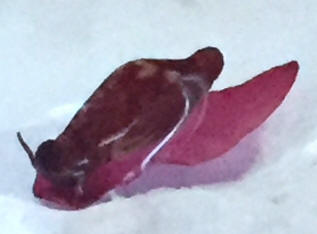 |
Re: Small Red Snail ID
9/15/16
Awesome!! Thank you, Bob! I'm definitely keeping him :)
<Yay!>
Rachel Fogle
<BobF>
|
<corr.> Small Red Snail ID: Ovulid- 9/15/16
Hi WWM crew!!
<Hey Rachel!>
I go to your site first to try to ID things and couldn't find anything
on this guy. It's a small snail, almost looks like a Stomatella. It's
pretty much bright red - both the shell and the foot.
<Yep, it’s a pretty little thing.>
I found it on a yellow polyp gorgonian (Menella sp.).
<Yep, these guys love ‘em.>
I thought it might be a pest but wanted to check. It's very pretty so I
don't want to harm it if I don't
have to! Any ideas?
<I’m sorry to say that although it does look like a Stomatellid, and
it’s undoubtedly pretty, it’s a pest (at least as far as the gorgonian
is concerned!). It’s an Ovulid, (family Ovulidae), a group of predatory
snails similar to cowries, that feeds on gorgonians (sea whips and
fans). These snails have an interesting two-fold defense strategy thanks
to a soft mantle typically extended over the shell. On the one hand, it
can mimic the color and texture of its prey to a surprising degree,
while on the other hand, the bright colors warn predators to stay away.
The mantle retains some of the noxious chemicals from whatever soft
coral the snail preys upon. Bottom line – this an interesting little
beauty, but I would remove it, along with any others that appear. Please
see the following links for more information:
http://www.wetwebmedia.com/gastropo.htm
http://www.wetwebmedia.com/MolluscPIX/Gastropods/Prosobranch%20PIX/Ovulids/OvulidsF1.htm
>
Photos below. It's less than 1/4 inch long and less than 1/8 wide.
<Thanks>
Thanks,
<You’re very welcome; I’m just sorry to be the bearer of bad news!>
Rachel Fogle
<Take care, Lynn Zurik>
|
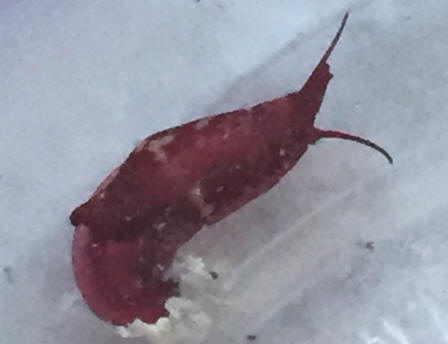 |
|
Yeeikes! Thank you Lynn. I mis-ID'd this as Stomatella sp.!!!
BobF 9/16/16
Snail Query - Ovulid
Hi Bob, I am so sorry that I didn't get to the snail query until today.
<Ahh! I'd sent a bad ID on thinking we/I'd missed you. B>
Re: Small Red Snail ID - Ovulid - 9/15/16
Thank you, Lynn!
<You are most welcome!>
I'll get rid of him. I'm sure my gorgonians will appreciate it.
<Oh yes, indeed!>
Rachel
<Take care, Lynn>
Re: Small Red Snail ID 9/16/16
Ha!!! I liked your ID better, Bob
<Heeee! Me too! B>
Rachel
|
|
|
Cowry id. If possible
2/24/15
Hi I've got a little hitch hiker i believe its an allied cowry but cant seem to
find any info about being reef safe and wondered if you would be able to shed
some light on the subject..
Thanx
<Does appear to be a Pseudosimnia sinensis; do eat Nephtheids...; soft corals.
Bob Fenner>
Re: Cowry id. If possible
2/24/15
Thank you very much
<Ah, welcome. BobF> |
.PNG)
.PNG) |
|
little cowry?– 6/24/13
I found this guy clinging to my carnation coral.
<Neat!>
Was wondering what he is and if he is a good hitchhiker or not. Please let
me know what you think. He has an awesome orange and white shell.
<Mmm, how large is this animal? This looks to be a Stomatella varia;
nocturnal algae grazers. Bob Fenner>
|
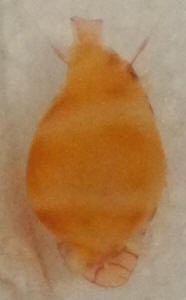 |
Re: little cowry?– 6/24/13
Hello again,
<Annie>
It is about the size of a pea. I have quite a few Stomatellas, but this one
has a full shell and not just a cap and also the underside of his shell
looks like a cowry shell (has the slit with ridges along the sides).
<Mmm, well... this could be a juvenile Leviathan cowry... we'll have to
wait and see as it grows! BobF>
Re: little cowry?
Are there any snails that have this coloring that are related to the bumble
bee snails? Upon closer inspection the shell is shaped like that more than a
cowry I think?
Thanks!
Andrea
<<Sending to LynnZ...>>
Re: little cowry?– 6/24/13
Thanks Bob - I'm on it! Take care, Lynn
<Thank you Lynn. BobF>
Little Cowry? Probable Predatory Ovulid – 6/24/13
<Hello, Lynn here this evening.>
I found this guy clinging to my carnation coral.
<That’s a great bit of information, thanks.>
Was wondering what he is and if he is a good hitchhiker or not.
<If it’s what I think it is, it’s not, at least as far as your
Dendronephthya/carnation coral is concerned.>
Please let me know what you think.
<I would love to see a detailed photo of this little fellow (one from above,
one from below), but I suspect that it’s a Dendronephthya predator in the
family Ovulidae and I would remove it asap along with any others like it.
Ovulids (Egg/“false” cowries) are similar to “true” cowries (family
Cypraeidae) in appearance and are predators of cnidarians (some specializing
in Dendronephthya spp.). Judging by what I can see of your individual’s
shell and foot, it appears to be something in the subfamily Prionovolvinae,
which includes a number of genera. Unfortunately, these snails can
vary to a surprising degree in shell and mantle coloration within each
species, so identification can be a challenge. If you wish to pursue
an ID (and are unable to send detailed photos) I would recommend beginning
with the genus Habuprionovolva (see link below), then move on to the other
genera within the subfamily (Diminovula, Prionovolva, etc.). Please
see the following links for comparison/more information:
Habuprionovolva aenigma:
http://www.gastropods.com/7/Shell_10247.shtml
Subfamily Prionovolvinae photos begin about 1/3 down the page (each photo is
a link to more info/photos):
http://www.gastropods.com/Taxon_pages/TN_Family_OVULIDAE.shtml
Photos of live Habuprionovolva spp. with mantles extended:
http://science.naturalis.nl/research/people/cv/reijnen/habuprionovolva>
He has an awesome orange and white shell.
<He certainly does; cowries and Ovulids have beautifully glossy shells.
What’s interesting about these guys is the degree to which they match their
host’s coloration and texture, thereby protecting themselves from predators
and unsuspecting hobbyists! Oddly enough, it’s not the shell that’s key to
their camouflage, it’s the extraordinary coloration and textures of the soft
mantle tissue that extends up and around the sides. This enables the
animal to practically disappear along the branches of its prey. These
really are beautiful animals. It’s just a shame that they prey on a
beautiful coral that in itself can be very difficult to keep! Please
let me/us know if there's anything else I/we can do to help. Take care, Lynn
Z>
Re: Little Cowry? Probable Predatory Ovulid – 6/24/13
<Hello Andrea, Lynn here again!>
Are there any snails that have this coloring that are related to the bumble
bee snails? Upon closer inspection the shell is shaped like that more than a
cowry I think?
<Do look at the Ovulids mentioned in the previous mail and see if anything
there looks like what you have. If I’m way off base, let me know and
we’ll give it another try!>
Thanks!
<You’re very welcome!>
Andrea
<Take care, Lynn Z)
Re: Little Cowry? Probable Predatory Ovulid – 6/24/13
Yes, it is the first species that you sent a photo link of.
<Yay!>
Too bad it's a predator snail...
<No kidding, it’s a shame.>
Maybe I'll have to set up a pico tank for this little guy, too pretty to let
die. Maybe I'll buy a few of these carnation corals and see if he'll
survive.
<That could get expensive, but if the coral was flourishing, perhaps one
small snail wouldn’t do enough damage to kill it off entirely.>
Thanks!
<It was a real pleasure!>
Annie
<Take care and good luck! Lynn Z> |
Flamingo Tongue Cowry Sorry to bother you but I have another
question regarding Flamingo Tongue Snails. My supplier tells me they
eat only Gorgonia and I have some in my tank. <that is
correct... and they should never be imported for this reason. Unless
you have developed a technique for growing their prey gorgonians
species faster that they can eat it> However, after introducing six
snails and the Gorgonia all of the snails promptly wandered off the
Gorgonia and seem to be grazing contentedly on algae and other food
sources in the tank. <they are definitely starving to death.
This is an age old observation and problem. Just because a snail, fish,
etc is eating an alternate food in captivity doesn't mean it is
surviving on it. They are dying of a dietary deficiency. It may take
weeks... some even hang in for months... but slow starvation is
inevitable here. I am honestly deeply saddened that yet more have been
imported. Were these sent along as freebies with an order of livestock
from an Atlantic supplier or were they ordered deliberately?> The
question is, are they going to survive or am I just being fooled and
they will soon starve to death. <the latter... this has been
observed by aquarists for 30 years!!!> They seem to be OK without
the Gorgonia. <based on what, my friend? We cannot see that they are
gaining or losing mass/muscle tissue so to speak. By virtue of the fact
that they are still moving? :)> Thanks for the help. Don Tope
<best regards, Anthony>
Re: Flamingo Tongue cowries Thanks for the response. I was
aware of the possibilities you mention in your response but wanted to
confirm my suspicions. I did not think that the mere fact of movement
was proof of a satisfactory situation for the organisms, hence my
query. <understood and agreed my friend> I, like you, do
not wish to waste life and that is why I asked the questions I did.
Would you suggest that I keep using Gorgonia (I can try to keep it -
Can obtain more if necessary). <hmmm.. at this point it gets a
bit discriminating. Some personal decisions here. We are discussing the
aquarium display of one not-easily-renewable resource (captively) with
another (the slow growing gorgonians). If you were studying the
mollusks with a purpose (scientific report, breeding study/programs,
etc) I'd feel comfortable with using the gorgonians as fodder. For
a merely aesthetic display, however... I'd cut your losses early.
No more snails or gorgonians. The problem is compounded by the fact
that these cowries eat an aposymbiotic gorgonian that is very difficult
to keep alive in captivity. And other hardy gorgonians are not
eaten/accepted readily. Alas, neither the host or parasite belong in
captivity with most aquarists.> Again, I do not want to waste
Gorgonia if it is a virtual certainty that it cannot be kept alive and
as a replenishing food source for the snails. Thanks for your
attention. <exactly... with kind regards, Anthony> Don Tope
| Unknown Cowry ID Egg cowry (Ovula ovum)
inappropriate. for captive care, diet=Sarcophyton
1/5/07 Hello, <Hi Brett, Mich here
today.> I have a question regarding potential harm from cowries
in the aquarium. I have a young nano tank that has two tiny
snails, a feather, two tiny blue legged hermits and two
small pieces of zoo coral, along with some live rock and sand.
I also have plans for a bit more soft coral. There is a cowry
amongst the grouping, which I was told is a "Burmese
Green" or "Green Burmese" Cowry, but have been
unable to find any information on this species. <This is an Egg
cowry (Ovula ovum). It is most definitely not
appropriate for your system. It is a predatory animal
who's diet consists primarily of Sarcophytons Alcyoniids,
leather corals. It shouldn't be kept in
captivity. The only exception being someone is over run
with leather corals and is trying to get rid of them, but I
can't imagine feeding the leathers to a cowry would be the
first choice of many aquarists.> From my research I
have found that some cowries can be harmful to your live rock and
soft corals, as well as other invertebrates, while others can
be fairly benign. <This is true.> I have included
an image of said cowry for your judgment. The shell is white with 3
rather faint greening band on the back (they are not very
noticeable in the image. The mantle is black and white, somewhat
zebra-like, and usually extends to cover almost the entire shell.
"he" has been burrowing in the sand for most of the time,
also spending a good bit of time cruising the live rock and the
glass. I want to make certain that this will be an okay tank
companion, but if this is a potentially troublesome species I know
of someone who could adopt it into a more suitable environment.
<Unfortunately, it may be difficult to find an appropriate home
for this animal. Please inform any prospective care
givers of this animals' nutritional
requirements.> Thank you for any information you may
be able to supply. Brett Amey |
|
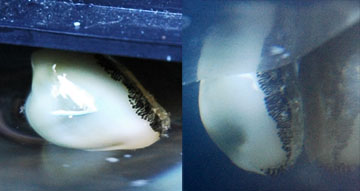
|
| Anemone identification -09/01/08 Hi there, In
July this year I photographed this pair of anemones <Mmm, no,
not anemones...> in about 30ft of water on a reef in North East
Tobago. I have no idea of their identity. Can you help please.
<They do look like Ovulids (Ovula sp.). Please scroll down and
see the pics of Ovula ovum on this page:
http://www.seaslugforum.net/showall.cfm?base=ovulids> thanks,
Rob Jackson <Ovula ovum is my guess. Best, Sara M.>
Re: Anemone identification - not anemones, Ovulids
09/01/08 P.S. Oh, I might also note that many Ovulids eat
soft corals (so it might make sense that you find these on/eating a
leather coral). :) Best, Sara M. Re: Anemone
identification... Ovulid et al. input... -09/02/08 Indeed,
I didn't want to say so, but I was thinking... how could this
picture have been taken in the "South Caribbean?" It must
have been taken elsewhere... either that or maybe there really are
clownfish off the cost of Kona... j/k lol ;) -Sara M. <Heeee!
May be! BobF> |
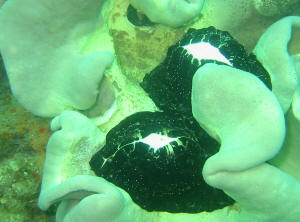 |
| Re: Anemone identification -Ovulids
09/02/08 Hi Sara, You have introduced me to a whole new
world with Seaslugforum.net Thanks so much. <Oh yes, it's a
fabulous site! You're most welcome :)> I am not a marine
biologist, but dive a bit and it's great to find a new link so
I can find my own answers. I have looked at lots of notes on Ovula
Ovum and that's what is going on the photo title. Bill Rudman
seems to say that these Ovulids are not common in the South
Caribbean, so maybe he will be interested if I send him the
details. <Yes. He might also be able to confirm the ID (or tell
you if it's actually some other Ovula sp).> Thanks again,
Rob Jackson (from UK) <De nada, Sara M. (from Cleveland, OH)>
<<Ummm, methinks this pic got somehow mixed up with others...
Neither the egg cowry, nor the soft coral (looks like a
Sarcophyton) occur in the tropical West Atlantic... More like
Indonesia, Malaysia, into the eastern Indian Ocean... Bob
Fenner>> |
| Unknown Cowry ID Egg cowry (Ovula ovum)
inappropriate. for captive care, diet=Sarcophyton
1/5/07 Hello, <Hi Brett, Mich here
today.> I have a question regarding potential harm from cowries
in the aquarium. I have a young nano tank that has two tiny
snails, a feather, two tiny blue legged hermits and two
small pieces of zoo coral, along with some live rock and sand.
I also have plans for a bit more soft coral. There is a cowry
amongst the grouping, which I was told is a "Burmese
Green" or "Green Burmese" Cowry, but have been
unable to find any information on this species. <This is an Egg
cowry (Ovula ovum). It is most definitely not
appropriate for your system. It is a predatory animal
who's diet consists primarily of Sarcophytons Alcyoniids,
leather corals. It shouldn't be kept in
captivity. The only exception being someone is over run
with leather corals and is trying to get rid of them, but I
can't imagine feeding the leathers to a cowry would be the
first choice of many aquarists.> From my research I
have found that some cowries can be harmful to your live rock and
soft corals, as well as other invertebrates, while others can
be fairly benign. <This is true.> I have included
an image of said cowry for your judgment. The shell is white with 3
rather faint greening band on the back (they are not very
noticeable in the image. The mantle is black and white, somewhat
zebra-like, and usually extends to cover almost the entire shell.
"he" has been burrowing in the sand for most of the time,
also spending a good bit of time cruising the live rock and the
glass. I want to make certain that this will be an okay tank
companion, but if this is a potentially troublesome species I know
of someone who could adopt it into a more suitable environment.
<Unfortunately, it may be difficult to find an appropriate home
for this animal. Please inform any prospective care
givers of this animals' nutritional
requirements.> Thank you for any information you may
be able to supply. Brett Amey |
|

|
| Who is this guy in my reef aquarium
4/12/06 Greetings from Portugal. <Hello Pedro> Can you
please tell me who is this guy in my reef aquarium? <Wish I
could... very nice photos... distinctive... has a shell like a
gastropod mollusk... an Ovulid?...> He's little, about half
inch (+- 1cm), and when he feels in danger a white liquid comes out
from he's shell (fig. 3). <Likely reproductive products and
no problem> I'm afraid about this white liquid and the
toxins on it since my shrimps don't like it and run away every
time this happens. <Mmm...> Best regards (sorry about my bad
English), Pedro Azevedo <Your English is perfect. Am going to
show these images about and see if someone can identify this
organism. Thank you for sending this along. Bob Fenner> |
| MOLLUSK - OVULID? Dear Bob,
Hope all is well with you
guys. I'm sure you've been off and about - any
interesting shell finds while as of recent? <I do have some
shells to show you...> Sorry
for the delay in getting back to you re the requested shell i.d.
I was over in the P.I. & Thailand until early this
month & it's been a crazy rush since my
return. Hunting for new employees, and still dealing
with our conflict of business interest situation re our ex-sales
manager! My only comment - stay away from legal schist
if at all possible - I don't have one (comment) re
Workman's Comp.!!!! <Heee! Well I know...>
Anyway, if the little orangish
gastropod is from the Med., and indeed an Ovulid (an Ovulid should
have cephalic tentacles - not to mention eyes?), then it most
closely resembles (without examining it firsthand) Simnia
nicaeensis Risso 1826. <Ahh!, thank you Marty>
If the fellow really is
determined to find out what it is - see if he knows
origin/locality, I'll then see if John can i.d. - he's
better on general misc. Gastropoda by far! As a parting
thought - if it is an Ovulid - it shouldn't last very long
without its host! <Agreed>
Regards, Marty <Hope to see you
soon. Hello to Angela, Harry, John... Bob F> Tideline |
|
 
|
| Snail and algae id Hello all( again!) For
some reason my snail pics never seemed to make it to you
all- so I'll try sending them as attachments this time =P
<They came through, not exactly sure what type of snail that
is... perhaps an egg cowry, maybe even specifically Dentiovula
dorsuosa, but hard to say for certain. More on those here: http://www.wetwebmedia.com/gastropo.htm
> Also I am attaching a picture of something that came on my
live rock. It is about 4" long, 2" tall, and has what
appears to be tiny red fur like things upon it. Part is white-like
a bleached coral, and the whole thing was fairly stiff
when i received it, but now is moving (swaying) with the current in
the tank. <Looks like an algae of some type, possibly a
Galaxaura species.> Any help would be very
appreciated. Best wishes to you all. <Cheers, J --
> |
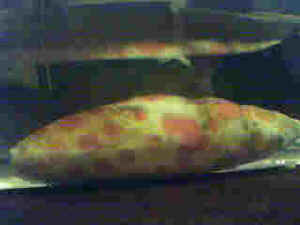 |
Flamingo Tongue Snail 6/31/05 Hi, Thanks for the great
site. I can't seem to find the answer to this question;
hopefully you can help me out. I found this beautiful snail
yesterday. I know better than to buy with out researching, but the guy
said it ate algae and I figured how much harm could a snail be ( I
know- stupid me). It looks just like the picture on your
site of the spotted Cyphoma. When you pick him up, his spots
move to the inside of his shell and his back is all off-white colored.
The spots come back when he calms down. He has the long black front and
I'm pretty sure it is a spotted Cyphoma. It doesn't
eat algae, does it? Is it poisonous? The LFS
won't take it back, so what should I do with it? I
currently have 2 anemones, a feather duster, a red general starfish, 5
(other) snails, a magenta Dottyback, a velvet damsel, an orange tail
damsel, three zebra damsels, a blue damsel, a reef hermit, and a
yellow-eye tang (plus about lbs. of live rock). Will this
new snail hurt any of them? If it doesn't eat algae,
what does it eat and where do I get it? I know I brought
this on myself, but I would appreciate any input you could
offer. For my own curiosity, why do his spots
move? Thanks, Stacy <Stacy, I can see why the
dealer wouldn't take it back. I'm sure what you have is a
Flamingo Tongue Snail. It won't live long unless you
have deep pockets to feed it a diet of gorgonians. I would question the
dealer as to why he is selling something like this that won't
live. James (Salty Dog)>
Flamingo Tongue Cowry Sorry to bother you but I have another
question regarding Flamingo Tongue Snails. My supplier tells me they
eat only Gorgonia and I have some in my tank. <that is
correct... and they should never be imported for this reason. Unless
you have developed a technique for growing their prey gorgonians
species faster that they can eat it> However, after introducing six
snails and the Gorgonia all of the snails promptly wandered off the
Gorgonia and seem to be grazing contentedly on algae and other food
sources in the tank. <they are definitely starving to death.
This is an age old observation and problem. Just because a snail, fish,
etc is eating an alternate food in captivity doesn't mean it is
surviving on it. They are dying of a dietary deficiency. It may take
weeks... some even hang in for months... but slow starvation is
inevitable here. I am honestly deeply saddened that yet more have been
imported. Were these sent along as freebies with an order of livestock
from an Atlantic supplier or were they ordered deliberately?> The
question is, are they going to survive or am I just being fooled and
they will soon starve to death. <the latter... this has been
observed by aquarists for 30 years!!!> They seem to be OK without
the Gorgonia. <based on what, my friend? We cannot see that they are
gaining or losing mass/muscle tissue so to speak. By virtue of the fact
that they are still moving? :)> Thanks for the help. Don Tope
<best regards, Anthony>
Re: Flamingo Tongue cowries Thanks for the response. I was
aware of the possibilities you mention in your response but wanted to
confirm my suspicions. I did not think that the mere fact of movement
was proof of a satisfactory situation for the organisms, hence my
query. <understood and agreed my friend> I, like you, do
not wish to waste life and that is why I asked the questions I did.
Would you suggest that I keep using Gorgonia (I can try to keep it -
Can obtain more if necessary). <hmmm.. at this point it gets a
bit discriminating. Some personal decisions here. We are discussing the
aquarium display of one not-easily-renewable resource (captively) with
another (the slow growing gorgonians). If you were studying the
mollusks with a purpose (scientific report, breeding study/programs,
etc) I'd feel comfortable with using the gorgonians as fodder. For
a merely aesthetic display, however... I'd cut your losses early.
No more snails or gorgonians. The problem is compounded by the fact
that these cowries eat an aposymbiotic gorgonian that is very difficult
to keep alive in captivity. And other hardy gorgonians are not
eaten/accepted readily. Alas, neither the host or parasite belong in
captivity with most aquarists.> Again, I do not want to waste
Gorgonia if it is a virtual certainty that it cannot be kept alive and
as a replenishing food source for the snails. Thanks for your
attention. <exactly... with kind regards, Anthony> Don Tope
|
|

